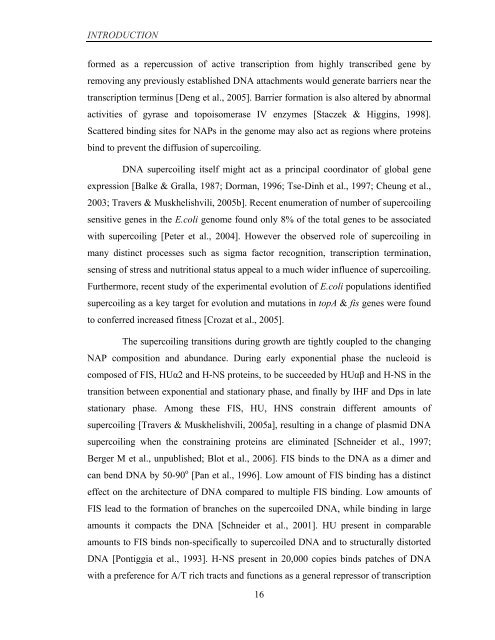Coordinated regulation of gene expression by E ... - Jacobs University
Coordinated regulation of gene expression by E ... - Jacobs University
Coordinated regulation of gene expression by E ... - Jacobs University
Create successful ePaper yourself
Turn your PDF publications into a flip-book with our unique Google optimized e-Paper software.
INTRODUCTION<br />
formed as a repercussion <strong>of</strong> active transcription from highly transcribed <strong>gene</strong> <strong>by</strong><br />
removing any previously established DNA attachments would <strong>gene</strong>rate barriers near the<br />
transcription terminus [Deng et al., 2005]. Barrier formation is also altered <strong>by</strong> abnormal<br />
activities <strong>of</strong> gyrase and topoisomerase IV enzymes [Staczek & Higgins, 1998].<br />
Scattered binding sites for NAPs in the genome may also act as regions where proteins<br />
bind to prevent the diffusion <strong>of</strong> supercoiling.<br />
DNA supercoiling itself might act as a principal coordinator <strong>of</strong> global <strong>gene</strong><br />
<strong>expression</strong> [Balke & Gralla, 1987; Dorman, 1996; Tse-Dinh et al., 1997; Cheung et al.,<br />
2003; Travers & Muskhelishvili, 2005b]. Recent enumeration <strong>of</strong> number <strong>of</strong> supercoiling<br />
sensitive <strong>gene</strong>s in the E.coli genome found only 8% <strong>of</strong> the total <strong>gene</strong>s to be associated<br />
with supercoiling [Peter et al., 2004]. However the observed role <strong>of</strong> supercoiling in<br />
many distinct processes such as sigma factor recognition, transcription termination,<br />
sensing <strong>of</strong> stress and nutritional status appeal to a much wider influence <strong>of</strong> supercoiling.<br />
Furthermore, recent study <strong>of</strong> the experimental evolution <strong>of</strong> E.coli populations identified<br />
supercoiling as a key target for evolution and mutations in topA & fis <strong>gene</strong>s were found<br />
to conferred increased fitness [Crozat et al., 2005].<br />
The supercoiling transitions during growth are tightly coupled to the changing<br />
NAP composition and abundance. During early exponential phase the nucleoid is<br />
composed <strong>of</strong> FIS, HUα2 and H-NS proteins, to be succeeded <strong>by</strong> HUαβ and H-NS in the<br />
transition between exponential and stationary phase, and finally <strong>by</strong> IHF and Dps in late<br />
stationary phase. Among these FIS, HU, HNS constrain different amounts <strong>of</strong><br />
supercoiling [Travers & Muskhelishvili, 2005a], resulting in a change <strong>of</strong> plasmid DNA<br />
supercoiling when the constraining proteins are eliminated [Schneider et al., 1997;<br />
Berger M et al., unpublished; Blot et al., 2006]. FIS binds to the DNA as a dimer and<br />
can bend DNA <strong>by</strong> 50-90 o [Pan et al., 1996]. Low amount <strong>of</strong> FIS binding has a distinct<br />
effect on the architecture <strong>of</strong> DNA compared to multiple FIS binding. Low amounts <strong>of</strong><br />
FIS lead to the formation <strong>of</strong> branches on the supercoiled DNA, while binding in large<br />
amounts it compacts the DNA [Schneider et al., 2001]. HU present in comparable<br />
amounts to FIS binds non-specifically to supercoiled DNA and to structurally distorted<br />
DNA [Pontiggia et al., 1993]. H-NS present in 20,000 copies binds patches <strong>of</strong> DNA<br />
with a preference for A/T rich tracts and functions as a <strong>gene</strong>ral repressor <strong>of</strong> transcription<br />
16
















